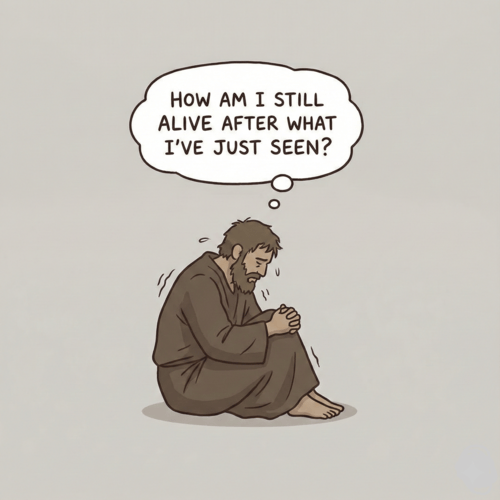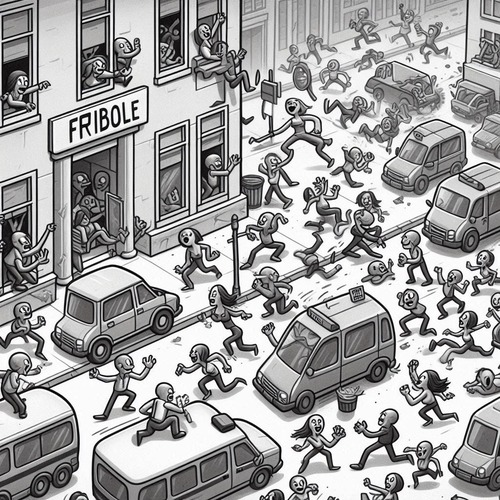Specified Complexity: Fresh Arguments for Design in Nature
JOE’S FIRST ENCOUNTER WITH SPECIFIED COMPLEXITY: Joe knows his name couldn’t have been written on the sand by random waves or wind patterns. The name is both complex (formed of specific arrangements of sand grains) and specified (matching the independent pattern of the name). Similarly, specified complexity helps us tell when something can’t—just can’t—be the product of chance…
In the field of scientific inquiry, few concepts have generated as much intellectual discourse in recent months as specified complexity. First formalised by mathematician and philosopher William Dembski in the late 1990s, this theoretical framework provides a mathematical and logical approach to distinguishing between patterns that emerge through random processes and those that suggest deliberate design.
Specified complexity occurs when an object or system displays both complexity (making it unlikely to occur by chance) and specification (conforming to an independently given pattern). This concept has become increasingly relevant in contemporary scientific discussions, particularly as our understanding of biological systems and cosmic phenomena continues to deepen.
UNDERSTANDING SPECIFIED COMPLEXITY
At its core, specified complexity rests on robust mathematical foundations derived from probability theory and information science. The concept employs Complex Specified Information (CSI) as a quantitative measure, where both the complexity of a system and its conformity to specified patterns can be mathematically evaluated.
The mathematical framework involves three key elements:
- Probability bounds that establish the likelihood of random occurrence
- Information theory principles that quantify the complexity of systems
- Pattern recognition criteria that determine specification
SPECIFIED COMPLEXITY IN NATURE
Biological Systems: The most compelling examples of specified complexity appear in biological systems. DNA, the foundation of life, exemplifies this concept perfectly. The genetic code displays:
- Extraordinary complexity through its vast information storage capacity
- Precise specification in its ability to code for functional proteins
- Information-rich sequences that coordinate biological processes
Recent research has revealed even deeper layers of complexity in cellular systems. The protein folding process, for instance, demonstrates remarkable specificity—proteins must fold into precise three-dimensional structures to function properly, and these structures are both complex and specified by physical and chemical requirements.
Cosmic Fine-Tuning
Beyond biology, specified complexity appears in the fundamental constants of the universe. The physical constants that govern our universe display an astonishing degree of fine-tuning:
- The gravitational constant must be precisely calibrated for stable galaxy formation
- The strong nuclear force must be exactly balanced for atomic stability
- The electromagnetic force must be finely tuned for chemical bonding
These constants exhibit both complexity (in their precise values) and specification (in their ability to support a life-permitting universe).
RELATIONSHIP TO INTELLIGENT DESIGN
Specified complexity serves as a key theoretical foundation for the broader intelligent design movement. The design inference methodology, developed alongside the concept, provides a rigorous framework for detecting design in natural systems.
Theoretical Framework: The relationship between specified complexity and intelligent design rests on several key principles:
- Design detection methods based on information theory
- Analysis of irreducible complexity in biological systems
- Statistical evaluation of pattern significance
Research in this field has expanded significantly, with peer-reviewed publications exploring the application of design detection methods across various scientific domains.
RECENT DEVELOPMENTS (2020-2024)
The past few years have witnessed significant advances in our understanding of specified complexity and its implications:
New Research Findings: Recent studies have revealed unprecedented levels of complexity in biological systems:
- Epigenetic research has uncovered additional layers of information storage in DNA, revealing complex regulatory networks that can be inherited across generations. Studies have demonstrated these epigenetic markers form intricate patterns that influence gene expression in ways that exhibit both complexity and specification.
- Quantum biology has demonstrated coherence effects in biological processes—particularly in photosynthesis and enzyme catalysis. Research published in 2023 has shown quantum effects maintain their coherence in biological systems far longer than previously thought possible at room temperature, thanks to their highly specified molecular architectures.
- New insights into cellular information processing have revealed sophisticated control systems that operate with remarkable precision at the molecular level. Recent studies have mapped previously unknown feedback loops and regulatory networks that demonstrate multiple layers of specified complexity.
Technological Applications: The concept of specified complexity has found practical applications in various fields:
- Biomimetic (technology that mimics nature) design principles inspired by natural systems have revolutionised multiple industries—from self-cleaning surfaces based on lotus leaf structures to more efficient wind turbine designs inspired by humpback whale flippers. Recent developments include new medical adhesives based on gecko feet mechanics and artificial photosynthesis systems that mimic the remarkably efficient energy transfer mechanisms found in plants.
- Advanced pattern recognition algorithms for scientific research have been developed using principles derived from specified complexity theory. These algorithms enable researchers to identify meaningful patterns in vast datasets that would be impossible to analyse manually. These have been particularly successful in genomics research and in analysis of astronomical data.
- AI systems that can detect and analyse complex specified patterns have emerged as powerful tools in fields ranging from medical diagnosis to materials science. Recent breakthroughs include AI systems that can identify subtle patterns in medical imaging that correlate with early-stage diseases, and new neural network architectures inspired by the principles of specified complexity that can distinguish between random noise and meaningful patterns in scientific data with remarkable accuracy.
CONCLUSION
The study of specified complexity continues to provide insights into the nature of design in our universe. From the intricate machinery of the cell to the fine-tuning of cosmic constants, we observe patterns that combine complexity with specification in ways that demand careful scientific investigation.
As our understanding of natural systems deepens, the evidence for specified complexity grows stronger, supported by advancing technology and new research methods. This field represents a fascinating intersection of mathematics, information theory, and natural science, offering compelling evidence for design in nature.
Specified Complexity—Related FAQs
- How are specified complexity and irreducible complexity interrelated? Specified Complexity (SC) and Irreducible Complexity (IC) are complementary concepts that work together to identify and analyse design patterns in nature, though they approach the question from different angles. SC provides the broader theoretical framework and mathematical tools for detecting design, while IC represents a specific subset of specified complexity found in functional systems. Modern research has strengthened the connection between these concepts, particularly in systems biology. New studies of cellular machinery have revealed increasingly sophisticated examples where both SC and IC are present, such as in DNA repair mechanisms and cellular quality control systems, which require multiple coordinated components and exhibit clear specified patterns.
- How do SC and IC together make a compelling case for intelligent design? SC and IC make a case for intelligent design by identifying and analysing patterns in nature that appear to require foresight and planning rather than emerging through undirected processes. SC provides the mathematical framework to demonstrate certain biological and cosmic features are both too complex to occur randomly and conform to independently specified patterns. Meanwhile, IC reveals systems where multiple, precisely-arranged components must be present simultaneously for the system to function at all—a characteristic that suggests intentional design rather than gradual development.
- What are the philosophical implications of SC? The concept of specified complexity raises profound questions about the nature of information, causation, and design in the universe. It challenges purely materialistic explanations for the origin and development of life while suggesting that information and purpose might be fundamental aspects of reality. These implications extend into discussions about consciousness, free will, and the relationship between mind and matter.
- How does the broader scientific community view SC? The scientific community’s response to SC has been varied, with some researchers embracing its mathematical framework while others express scepticism about its applications. Many mainstream scientists acknowledge the presence of complex patterns in nature but differ in their interpretation of what these patterns indicate. The ongoing dialogue has led to productive discussions about the nature of scientific evidence and the philosophical implications of design detection methods.
- What alternative explanations exist for patterns of specified complexity? Some researchers propose emergent properties and self-organising systems can produce patterns that appear to exhibit specified complexity without requiring external design. Natural selection combined with genetic drift and other evolutionary mechanisms is often cited as a potential explanation for biological complexity. Additionally, multiverse theories have been proposed to address cosmic fine-tuning observations.
- What new research frontiers are emerging in this field? Emerging frontiers include the application of artificial intelligence to detect and analyse specified complexity patterns in biological data and the investigation of quantum biology’s role in maintaining complex biological information. The field is also exploring connections between SC and consciousness studies, as well as potential applications in synthetic biology and artificial life research.
- How might SC research impact technology and innovation? Research in this field is inspiring new approaches to biomimetic engineering and artificial intelligence design. Understanding how natural systems implement SC could lead to breakthrough technologies in information storage, processing, and self-organising systems. These insights are particularly valuable for developing more efficient and robust technological solutions.
Specified Complexity—Our Related Posts
Editor's Pick

Christian Obedience: God’s Empowerment or an Act of Our Will?
Every Christian knows the struggle. You’re fighting a besetting sin—again. You’ve resolved to do better—again. And you’re wondering: Should I [...]

The Throne-Room Vision: Who Did Isaiah See?
The scene is unforgettable: Isaiah stands in the temple, and suddenly the veil between heaven and earth tears open. He [...]

The Angel of the Lord: Can We Be Certain It Was Christ All Along?
Throughout the Old Testament, a mysterious figure appears: the Angel of the LORD. He speaks as God, bears God’s name, [...]
SUPPORT US:
Feel the Holy Spirit's gentle nudge to partner with us?
Donate Online:
Account Name: TRUTHS TO DIE FOR FOUNDATION
Account Number: 10243565459
Bank IFSC: IDFB0043391
Bank Name: IDFC FIRST BANK






